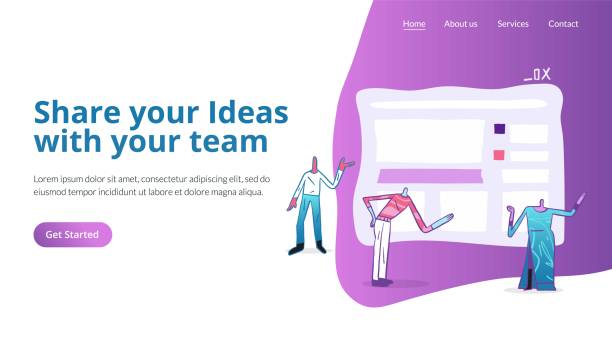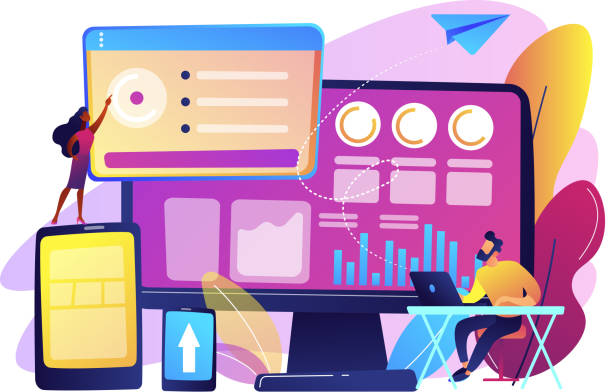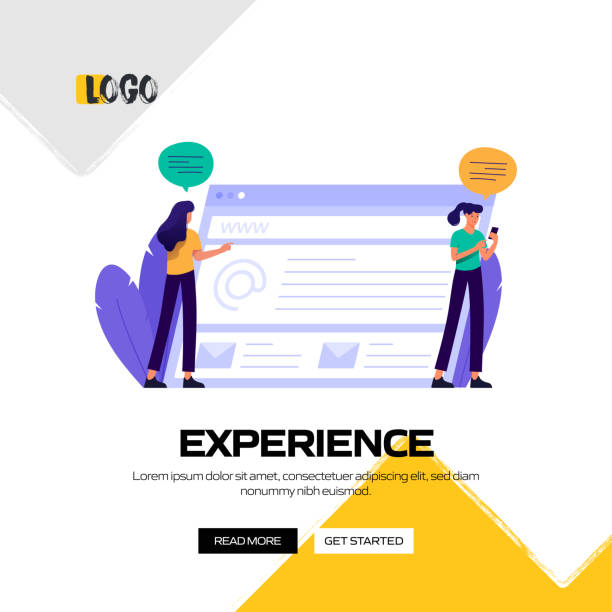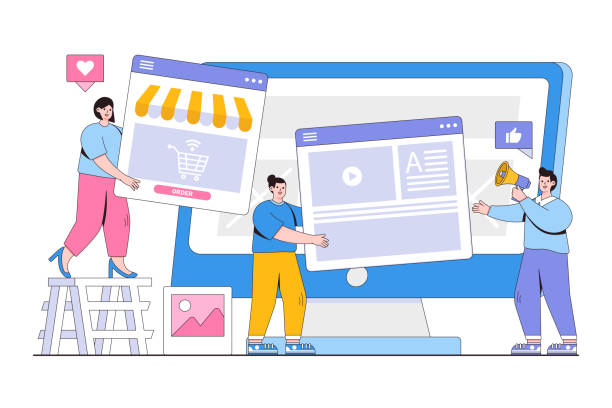Introduction to SEO-Optimized Website Design and Its Importance

In the current digital age, an online presence is of vital importance for any business or individual.
But simply having a website is not enough; your website must be discoverable to your audience.
This is where the concept of #SEO-Optimized_Website_Design becomes important.
#SEO, or Search Engine Optimization, is a process that helps your website achieve a higher ranking in the search results of Google, Bing, and other search engines.
The main goal of designing a website with SEO principles in mind is to increase organic traffic and attract targeted visitors.
This explanatory and educational approach helps you gain a better understanding of this complex process and realize why SEO is not just an option, but a necessity.
From code structure to loading speed and user experience, every component of your website can impact its SEO ranking.
Ignoring SEO means missing out on countless opportunities to be seen and compete in the online market.
Did you know that customers’ first impression of your company is your website? With a powerful corporate website from RasaWeb, multiply your business’s credibility!
✅ Custom and eye-catching design tailored to your brand
✅ Improved user experience and increased customer acquisition
⚡ Get a free consultation!
Key SEO Criteria in Website Design

To have an SEO-optimized website design, special attention must be paid to a set of specialized criteria and principles.
Among these criteria is the crawlability and indexability by search engines.
A website must be designed so that search engine bots can easily scan its pages and understand its content.
SEO-friendly URL structures, the use of XML sitemaps, and robots.txt files are among the tools that help you in this regard.
Also, page loading speed is of paramount importance.
Users and search engines alike prefer faster sites.
Tools like Google PageSpeed Insights can guide and help you improve this vital factor.
Furthermore, Responsive Design, which displays your website correctly on any device from mobile to desktop, is another fundamental criterion.
Google prioritizes websites that are optimized for mobile.
Adhering to these principles at the core of website architecture forms the foundation for your long-term SEO success.
Content Optimization for Search Engines

Content is king, but not just any content; content that is optimized for search engines and users.
In the process of SEO-optimized website design, a significant part is dedicated to content creation and optimization.
This includes keyword research, correct usage of keywords in titles, body text, meta descriptions, and HTML tags.
Your content must be explanatory, educational, and most importantly, high-quality and valuable to the audience.
Search engines give higher rankings to content that addresses user needs and provides comprehensive and accurate information.
Besides keywords, content structure is also vital; using headings (H1, H2, H3), short paragraphs, and lists increases readability and helps search engines understand the text structure.
Internal Linking is another important aspect of content optimization that helps distribute page authority across the site and guides users.
This analytical process allows you to produce content that is both appealing to humans and understandable to bots.
The table below shows examples of content types and their impact on SEO.
| Content Type | SEO Impact | Example |
|---|---|---|
| Blog Articles | Increased keywords, organic traffic, domain authority | Article “10 Ways to Improve Website SEO” |
| Service/Product Pages | Targeting commercial keywords, converting visitors to customers | Page “SEO-Optimized Website Design Services” |
| Comprehensive Guides | In-depth answers to questions, building trust, natural backlinking | Complete guide “How to build a website?” |
| Questions & Answers (FAQ) | Direct answers to user needs, improving featured snippets | Page “Frequently Asked Questions about SEO” |
The Role of User Experience (UX) in SEO

In today’s world, User Experience (UX) is no longer just a desirable feature, but a vital factor in the success of your website’s SEO.
Google and other search engines are increasingly emphasizing UX-related factors for website ranking.
An SEO-optimized website design is a website that is not only optimized for search engines but also provides a pleasant and seamless experience for users.
This includes easy navigation, attractive visual design, good text readability, and accessibility for all users.
When users can easily find the information they are looking for, they spend more time on your site (higher Dwell Time) and the Bounce Rate decreases.
These signals indicate to search engines that your content is valuable and should be displayed in higher rankings.
Improving UX is a specialized and guiding approach that involves analyzing user behavior, conducting A/B tests, and listening to feedback.
Remember that the ultimate goal of SEO is user satisfaction; if users are satisfied with your site, search engines will also support it.
Are you frustrated by losing customers who visited your site to make a purchase?
RasaWeb is your specialized solution for a successful online store.
✅ Significant increase in your online sales
✅ Building trust and professional branding with customers⚡ Get a free consultation from RasaWeb experts!
Technical Aspects of SEO-Optimized Website Design

The foundation of an SEO-optimized website design lies in its technical aspects.
This part of SEO might not be very tangible for ordinary users, but it is vital for search engines.
This includes aspects such as clean and logical site architecture, the use of canonical tags to prevent duplicate content, implementing structured data (Schema Markup) to help search engines better understand your content, and image optimization (compression and use of Alt Text).
This specialized approach helps ensure that your website is properly crawled and indexed by search bots.
Also, website security using an SSL certificate (HTTPS) is another important technical aspect; Google has explicitly stated that it prioritizes HTTPS websites in rankings.
Managing 404 errors and 301 redirects for deleted or moved pages is also highly important to preserve user experience and SEO authority.
These technical aspects serve as a strong foundation for your overall SEO strategy and are essential for achieving high rankings in search results.
This explanatory section emphasizes the technical complexities of SEO.
Backlinks and Domain Authority

One of the main pillars of SEO, especially for SEO-optimized website design, is the concept of backlinks and domain authority.
Backlinks are links from other websites to your site and are considered a “vote of confidence” from other sites to your content.
The more numerous and higher quality the incoming backlinks to your site, the more your domain authority increases with search engines, and your chances of ranking higher in search results improve.
But not all backlinks are equal; quality is more important than quantity.
Backlinks coming from reputable sites relevant to your field of activity have more value.
A precise analysis of competitors’ backlink profiles can improve your link-building strategy.
Natural link-building methods such as creating valuable content that others link to (Content Marketing), as well as Outreach and collaboration with influencers, can be utilized.
Avoiding spammy and unnatural link-building is very important, as it can lead to penalties from Google.
Understanding this aspect of SEO is essential for your website’s long-term success and serves as a comprehensive explanation in this field.
Essential Tools for Website SEO Analysis and Improvement

To ensure that your SEO-optimized website design functions correctly and is on a path of continuous improvement, the use of specialized SEO tools is vital.
These tools allow you to monitor your site’s performance, identify technical issues, analyze competitor keywords, and find new opportunities to improve your ranking.
Among the most widely used tools is Google Search Console, which provides direct information about your site’s performance in Google search results.
Google Analytics is also essential for analyzing website traffic and user behavior.
Paid tools such as Ahrefs, Semrush, and Moz also offer much more advanced capabilities in keyword research, backlink analysis, and competitor monitoring, which are very useful for guiding your strategic decisions.
Regular use of these tools helps you always stay informed about your site’s SEO status and make necessary changes when needed.
This educational section introduces tools that are essential for any SEO specialist or website owner.
The table below lists some of these tools and their main applications.
| Tool | Main Application | Type |
|---|---|---|
| Google Search Console | Search performance reports, technical issues, indexing | Free |
| Google Analytics | Website traffic analysis, user behavior, traffic sources | Free |
| Ahrefs | Keyword research, backlink analysis, competitor monitoring | Paid |
| Semrush | Keyword research, competitor analysis, content SEO | Paid |
| Moz Pro | Domain authority, ranking tools, local SEO | Paid |
Local SEO and Website Design for Local Businesses

For businesses whose target audience is located in a specific geographical area, local SEO is of particular importance.
SEO-optimized website design for local businesses requires specific specialized approaches.
This includes optimizing Google My Business, clearly and consistently embedding contact information and addresses (NAP: Name, Address, Phone Number) across all website pages, and creating content relevant to the target geographical area.
For example, a bakery in Tehran should have pages targeting keywords like “bakery in Tehran” or “best bakery in [specific area]”.
Receiving positive reviews from local customers and responding to them on Google My Business and other review platforms also plays a key role in local SEO.
Guiding users to find your business through maps and directions on the site also improves user experience.
Using local keywords in content, meta tags, and page titles helps search engines introduce your business to local users who are looking for your services or products.
This strategy provides a direct path to attracting walk-in customers and increasing sales for physical businesses.
Did you know that poor online store design can drive away up to 70% of your potential customers? RasaWeb revolutionizes your sales with professional and user-friendly e-commerce website designs.
✅ Significant increase in sales and revenue
✅ Full optimization for search engines and mobile
⚡ [Get a free consultation from RasaWeb]
Challenges and Future Trends in SEO-Optimized Website Design

The world of SEO is constantly changing and evolving, making SEO-optimized website design a dynamic field.
New challenges such as increased competition, continuous changes in Google’s algorithms, and the emergence of new technologies require analytical and up-to-date approaches.
For example, Voice Search SEO has gained increasing importance with the spread of voice assistants like Siri and Google Assistant.
Also, Artificial Intelligence (AI) plays a more prominent role in data analysis and personalizing search results, which itself creates intriguing content about the future of SEO: Are AI algorithms moving towards reducing the need for traditional SEO or making it more complex? Trends like Core Web Vitals, which emphasize visual user experience and loading speed, indicate that Google is moving towards improving user experience as a primary ranking factor.
Video and Image SEO have also gained more importance with the increased consumption of visual content.
To succeed in the future, one must be aware of the latest news and developments in this field and continuously review and adapt their SEO strategies.
This adaptability is the key to survival and progress in the digital space.
Conclusion and Next Steps in SEO-Optimized Website Design

In summary, SEO-optimized website design is a complex and multifaceted process that includes technical, content, user experience, and link-building aspects.
Success in this field requires continuous commitment and effort, as search engine algorithms and user behavior are always evolving.
By adhering to the guiding and explanatory principles presented in this article, you can lay the foundations for a strong and visible online presence for your business.
Your next steps should include: conducting a comprehensive SEO audit for your current website, developing a precise keyword strategy, regularly producing high-quality and valuable content, continuously improving user experience, and creating a healthy link-building plan.
Additionally, continuous monitoring of site performance using SEO tools and data analysis is essential for identifying opportunities and challenges.
Optimizing your website for search engines not only drives more traffic to you but also enhances your brand’s credibility and helps you gain an edge in the competitive digital space.
This is a long-term investment whose results will be sustainable and valuable.
Frequently Asked Questions
| Question | Answer |
|---|---|
| What is SEO-optimized website design? | SEO-optimized website design refers to designing and coding a website that is technically, content-wise, and structurally optimized so that search engines can easily crawl and index it and assign it a higher ranking in search results. |
| Why is SEO-optimized website design important? | Its importance lies in increasing website visibility in search engine results (like Google), attracting more organic traffic, improving user experience, and ultimately increasing conversion rates (sales or desired actions). |
| What are the most important technical SEO factors in website design? | High loading speed, responsiveness (Mobile-Friendly), appropriate URL structure, use of SSL certificate (HTTPS), XML sitemap, and robots.txt file. |
| What impact does Responsive Design have on SEO? | Since a large portion of searches are conducted via mobile, Google prioritizes responsive sites. Responsive design improves user experience and reduces bounce rate, both of which help SEO. |
| How does website loading speed affect SEO? | Loading speed is an important ranking factor for Google. Slow sites lead to a poor user experience, increased bounce rates, and lower rankings in search results. |
| What is the role of URL structure in SEO? | Short, readable URLs that include relevant keywords help both users and search engines better understand the page’s topic, which positively impacts SEO. |
| What is the importance of using Title Tags and Meta Descriptions in SEO design? | These tags provide information about the page’s content to search engines and users. Optimizing them with appropriate keywords increases click-through rate (CTR) and improves content understanding by search bots. |
| What is the importance of Image Optimization in SEO? | Reducing image size to increase site speed, using descriptive Alt text (including keywords) to describe the image to search engines, and increasing the chance of display in Google Image Search. |
| How does Internal Linking help SEO? | Internal linking helps search engines better understand the site structure, distributes authority (PageRank) throughout the site, and guides users to relevant pages, which improves user experience and reduces bounce rate. |
| What is the connection between User Experience (UX) and SEO? | Google values sites that provide a good user experience. Attractive visual design, easy navigation, readable content, and high speed all contribute to improved UX, which in turn leads to reduced bounce rates, increased time on site, and positive signals to search engines. |
And other services from Rasa Web Advertising Agency in the field of advertising
Smart Brand Identity: Professional optimization to improve SEO ranking using an SEO-focused content strategy.
Smart Sales Automation: An innovative service to increase website visits through marketing automation.
Smart Digital Branding: A professional solution for analyzing customer behavior with a focus on SEO-focused content strategy.
Smart Advertising Campaign: Revolutionize SEO ranking improvement by customizing user experience.
Smart Advertorial: A combination of creativity and technology for digital branding through key page optimization.
And over a hundred other services in the field of internet advertising, advertising consulting, and organizational solutions
Internet Advertising | Advertising Strategy | Advertorial
Resources
? To reach the peak in the digital world, RasaWeb Afarin Digital Marketing Agency paves the way for your business’s success by offering comprehensive services including professional website design, SEO, and online advertising.
📍 Tehran, Mirdamad Street, next to Bank Markazi, Kazeroon Janoubi Alley, Ramin Alley, No. 6

